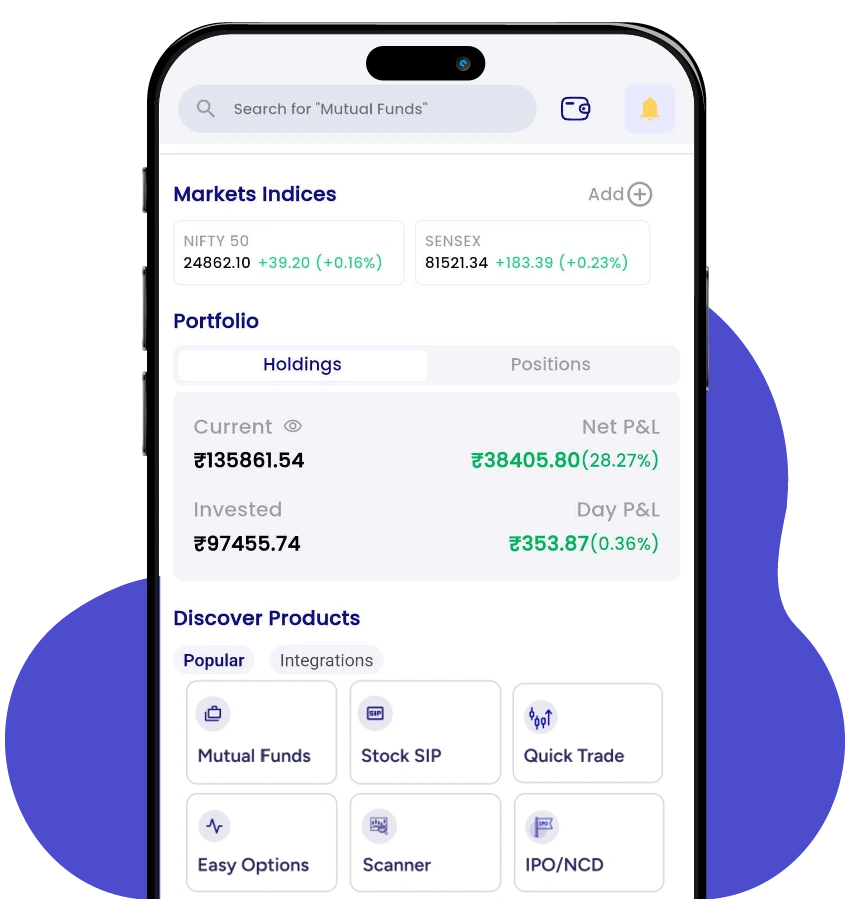What is Portfolio Risk?
- 25th June 2025
- 8 min read
Do you know that the BSE Sensex and NSE Nifty fell by 38% after the outbreak of COVID‐19 in 2021? While stock market investment can generate higher income, it involves significant market risks.
The COVID-19 pandemic and its massive impact on Indian companies show why it is crucial to establish portfolio risk management to safeguard the portfolio and its value. Read this blog to know what is portfolio risk, the different types of it, and the tools needed to manage them.
What is Risk in Portfolio Management?
Before jumping into the process of managing portfolio risk, you must understand the portfolio risk meaning. Portfolio risk is the possibility that an individual could lose the value of his or her investments.
Risk in investment portfolios is the circumstance when the return from your total investment will be lower than your expected return. Sometimes, investment risks lead to losing all of your investment, which can affect your financial goals. Whether you are investing in mutual funds or buying stocks, you carry some form of risk. Understanding the portfolio risks helps you manage them effectively.
By employing effective portfolio risk management techniques, you can minimise the risks involved in your portfolio. That is why experienced investors balance their rewards and risks by diversifying their investments.
Why is It Important to Know Portfolio Risks?
Understanding portfolio risks is not only important to manage risks, but also helps in generating higher returns. Since portfolio risks can impact any of your assets, understanding them helps assess, measure, and manage them in your portfolio.
Portfolio risk management allows investors to build portfolios to generate returns and manage risks from market fluctuations. Understanding these risks can help to avoid misjudgment and prevent fraud. Your investment objectives, time horizon, experience, and monthly expenses may help you analyse your risk tolerance more efficiently.
What are the Different Types of Portfolio Risks?
Understanding the different types of risks allows you to make informed decisions and take action to manage them. The different types of portfolio risks are detailed below:
-
Liquidity Risks
Liquidity risks arise when you are unable to convert your asset into money. This can lead to your loss as you have to sell your high-value assets during a market dip at a lower price.
-
Market Risks
Market risk is one of the most unavoidable types of risks that affect your portfolio. Your assets may likely lose value due to changes in interest rates, geopolitical events, and inflation.
-
Inflation Risks
Inflation risks let you buy a lesser amount of assets with the same amount of money. This type of risk impacts fixed-income investments more than equities.
-
Credit Risks
Credit risks include investments that decrease in value because of a default by a debt instrument issuer. This risk is common in corporate bonds where the creditworthiness of the issuer determines the bond’s value.
-
Concentration Risks
This type of risk happens when you have invested too much of your money in a single asset class or a sector. Your portfolio will suffer a hit if the particular asset class or sector experiences a downturn.
-
Reinvestment Risks
Reinvestment risks are risks that result from the loss of reinvesting the previously invested amount at a lower rate than before. This type of risk is common among investors who invest in fixed-income investments that have a maturity date.
How to Calculate Portfolio Risks?
Calculating your portfolio risks is easy, as it requires various metrics. Below are the metrics that you may use to calculate your portfolio risk:
-
Standard Deviation
A standard deviation determines the stability of a portfolio by measuring the investment risks and consistency of an investor’s earnings. A standard deviation estimates the movement of your portfolio about the market over time.
-
Beta
Beta is a metric that analyses the volatility of a particular investment compared to the benchmark index. If the beta value is 1, it means the investment is neither more volatile nor less volatile than the benchmark index. A beta value less than shows it is less volatile than the benchmark index, while a beta value more than 1 indicates the investment is more volatile than the index.
-
Sharpe
Sharpe ratio is a risk-adjusted measure that helps you understand how much return you will earn for every unit of risk taken. A higher Sharpe ratio means your investment is worth the risks.
-
Sortino
A sortino ratio helps to understand how much your returns will dip below a certain threshold. This ratio helps investors who care more about losing money.
How to Manage Portfolio Risks?
A portfolio manager plays a crucial role in managing the risks involved in your portfolio. Below are the different ways portfolio managers address portfolio risks:
-
Rebalancing
Portfolio managers prioritise the rebalancing strategy, which adjusts the portfolio to maintain the desired asset allocation.
-
Diversifying Investments
Diversification in investment means buying assets from different financial categories. Diversifying your portfolio is the foremost strategy to manage risks. Diversifying your investments across different assets like stocks, bonds, and cash can save your portfolio against risks.
-
Passive Management Strategies
Portfolio managers sometimes consider passive approaches to managing risks by indexing. The process of indexing offers lower fees and diversification.
-
Anticipating Economic Events
Portfolio managers also anticipate economic events or different news that may affect market conditions. They also look for historical data on which events have occurred and how they might affect different investments.
Important Tools to Assess and Manage Portfolio Risks
Portfolio managers use different types of tools and techniques to manage the risks. Below are the crucial tools to manage portfolio risks:
-
Portfolio Management Software
Portfolio management software is an essential tool for analysing investor portfolios. You can access real-time data like risk metrics and portfolio performance with this software.
-
Risk Management Software
Managers can also use risk management software to identify and manage risks associated with investors’ portfolios. Along with analysing a portfolio’s risk exposure, this software recommends appropriate risk management strategies.
-
Monte Carlo Simulations
Monte Carlo simulations provide statistical techniques that predict future portfolio returns considering different market scenarios.
Role of Risk Tolerance
As an investor, your risk tolerance plays a crucial role in managing your portfolio risks. It is the degree of risk that you are willing to accept while investing. Investors must be ready to face losses after deciding to create a portfolio. The threshold at which you cannot afford to face losses is considered your risk tolerance.
The risk tolerance of each investor may differ based on their investment goals, financial condition, and personal needs. If you have a long time before retirement and have a steady source of income, you may have a higher risk tolerance. The reason behind this is that you have a long time to recover from the losses you faced.
However, if you are close to retirement and about to lose a steady source of income, then you may have a lower risk tolerance. Nevertheless, you can measure your risk tolerance by analysing your portfolio and your monthly earnings and expenses. You may also seek help from a financial advisor.
Final Thoughts
Understanding what is portfolio risk is crucial to analysing the different types of risks associated with your investments. With the help of portfolio risk management, you can not only analyse the risks involved in your portfolio but also take appropriate measures to address them.
Want to invest in securities and start your investment journey? Download the application of PL Capital Group – Prabhudas Lilladher to open a Demat account for free! You may also avail portfolio management services using the PL app, which can help you avoid market risk and gain stable returns.
Frequently Asked Questions
1. How do market conditions lead to portfolio risk?
Market conditions like price fluctuations due to factors like changes in interest rates, stock prices, and foreign exchange rates have a direct impact on the portfolio and lead to risks.
2. What is the impact of inflation on portfolio risk?
Inflation can lead to portfolio risk that reduces an investment’s returns by a decline in purchasing power. You have to purchase fewer goods by spending a higher amount.
3. How does portfolio risk change over time?
Portfolio risk changes over time due to changes in asset values, market conditions, diversification of assets, and portfolio rebalancing.
4. What is the role of asset correlation in portfolio risk?
Asset correlation plays a crucial role in managing portfolio risks. It diversifies the portfolios and hedges against risk. An asset with a correlation with the market makes it lose its value in recessions. However, assets with a low correlation with the market may gain value.





